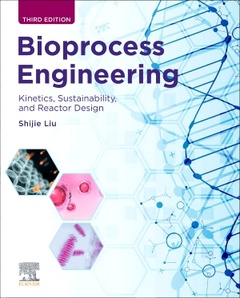Bioprocess Engineering (3rd Ed.) Kinetics, Sustainability, and Reactor Design
Auteur : Liu Shijie

Bioprocess Engineering: Kinetics, Sustainability, and Reactor Design, Third Edition, is a systematic and comprehensive textbook on bioprocess kinetics, molecular transformation, bioprocess systems, sustainability and reaction engineering. The book reviews the relevant fundamentals of chemical kinetics, batch and continuous reactors, biochemistry, microbiology, molecular biology, reaction engineering and bioprocess systems engineering, introducing key principles that enable bioprocess engineers to engage in the analysis, optimization, selection of cultivation methods, design and consistent control over molecular biological and chemical transformations. The quantitative treatment of bioprocesses is the central theme in this text, however more advanced techniques and applications are also covered.
Part I: Fundamentals
1. What is Bioprocess Engineering?
2. An Overview of Biological Basics
3. An Overview of Chemical Reaction Analysis
4. Batch Reactor
5. Ideal Flow Reactors
Part II: Kinetics and Molecular Interactions
6. Kinetic Theory and Reaction Kinetics
7. Enzymes
8. Chemical Reactions on Solid Surfaces
9. Protein-Ligand Interactions
10. Molecular Regulation
Part III: Cells: Function and Manipulations
11. Cell Metabolism
12. Evolution and Genetic Engineering
Part IV: Cultivation and Fermentation
13. How Cells Grow
14. Cell Cultivation
Part V: Bioprocess System and Reaction Engineering
15. Sustainability and Stability
16. Combustion, Reactive Hazard and Bioprocess Safety
17. Mass Transfer Effects: Immobilized and Heterogeneous Reaction Systems
Part VI: Reactor Engineering and Quality Design
18. Bioreactor Design & Operation
19. Real Reactors and Residence Time Distributions
20. Design of Experiment
- Includes biological molecules and chemical reaction basics, cell biology and genetic engineering
- Describes kinetics and catalysis at molecular and cellular levels, along with the principles of fermentation
- Covers advanced topics and treatise in interactive enzyme and molecular regulations, also covering solid catalysis
- Explores bioprocess kinetics, mass transfer effects, reactor analysis, control and design
Date de parution : 04-2020
Ouvrage de 958 p.
21.4x27.6 cm
Thèmes de Bioprocess Engineering :
Mots-clés :
aceptic operation; allosteric binding; allosteric enzyme; allosteric interaction; batch cultivation; batch growth phases of cells; binary reactions; biohazard; biologics; biorefinery; biostability; biotransformation; carbohydrates; catalysis; catalyst stability; cell; cell growth kinetics; cell lines; cell selection; collision theory; concentration; conformal structural change; continuous cultivation; cooperative adsorption; cooperative kinetics; cross-membrane transport; crystallizer; CSTR; cumulative age distribution; distributed feed and/or withdrawing PFR; DNA; DNA recombination; dogma of biology; domain swapping; effectiveness factor; energy balance; enzyme; enzyme catalysis; enzyme catalytic rate; enzyme polymorph; enzyme-PH coupling; explosion; external age distribution; fast equilibrium step; fed-batch cultivation; feed stability; fermentation; fermenter; fractional factorial design; gasification; genetic manipulation; glycolysis; green chemistry; heterogeneous systems; homosteric binding; ideal flow reactors; immobilization; inhibition; internal age distribution; LHHW; mammalian cell; mass balance; mass transfer effects; metabolic pathway; Michaelis-Menten kinetics; mixed culture; molecular interaction; molecular regulation; Monod equation; multilayer adsorption; multimolecular reactions; multiple steady states; mutation; nonideal surface reaction; parametric estimation; particle size effect; PFR; polyauxic growth; primary products; prion; product quality control; productivity; protein oligomerization; pseudosteady state hypothesis; pyrolysis; quality impartial design (QID); reaction; reaction rate; reactivity hazard; reactor; reactor optimization; reactor runaway; reactor scale up; reactor selection; reactor sizing; reactors; regulatory; response surface method (RSM); restriction enzyme; RNA



